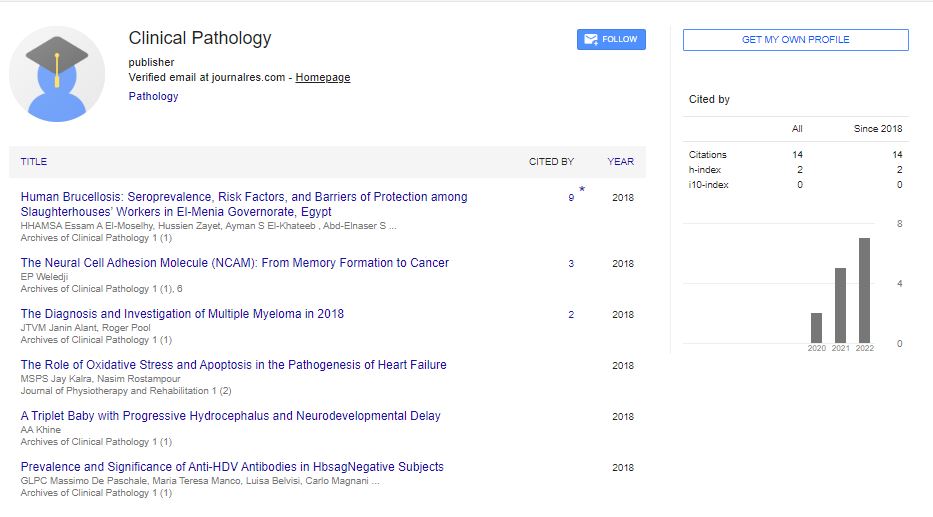Commentary, Arch Clin Pathol Vol: 6 Issue: 4
Innovations in Cytopathology: Microscopic Analysis to Molecular Insights
Liam Paul*
1Department of Pathology, Kocaeli University, Kocaeli, Turkey
*Corresponding Author: Liam Paul,
Department of Pathology, Kocaeli University,
Kocaeli, Turkey
E-mail: paulliam@gmail.com
Received date: 27 November, 2023, Manuscript No. ACPY-24-124235;
Editor assigned date: 29 November, 2023, PreQC No. ACPY-24-124235 (PQ);
Reviewed date: 13 December, 2023, QC No. ACPY-24-124235;
Revised date: 21 December, 2023, Manuscript No. ACPY-24-124235 (R);
Published date: 29 December, 2023 DOI: 10.4172/acpy.100099
Citation: Paul L (2023) Innovations in Cytopathology: Microscopic Analysis to Molecular Insights. Arch Clin Pathol 6:4.
Description
Cytopathology is a specialized discipline within pathology that focuses on the study of individual cells to diagnose diseases. Through the microscopic examination of cells obtained from various bodily sources, cytopathologists play a crucial role in identifying abnormalities, guiding treatment decisions, and monitoring disease progression.
Fundamentals of cytopathology
Cytopathology involves the examination of cells obtained through non-invasive procedures such as Fine Needle Aspiration (FNA), exfoliative cytology, or brushings. The analysis of cellular morphology, structure, and alterations aids in diagnosing various conditions, including cancers, infections, inflammatory diseases, and precancerous lesions.
Fine needle aspiration cytology utilizes a thin needle to extract cells from palpable masses or organs, providing rapid and minimally invasive diagnostic information. Exfoliative cytology involves the collection of cells shed from body surfaces, such as the cervix (Pap smear) or respiratory tract (sputum), allowing for early detection of abnormalities.
Methodologies in cytopathology
The examination of cellular samples in cytopathology involves various techniques and staining methods. Microscopic evaluation of stained cells allows cytopathologists to observe cellular characteristics, nuclear features, and cytoplasmic changes indicative of diseases. Special staining techniques, such as immunocytochemistry aid in identifying specific markers or genetic alterations within cells, aiding in precise diagnosis and classification.
Role in disease diagnosis and management
Cytopathology plays a pivotal role in diagnosing a spectrum of diseases, particularly cancers. It assists in tumor classification, staging, and determination of treatment strategies. For instance, cervical cancer screening through Pap smears has significantly reduced the incidence of cervical cancer by detecting precancerous lesions early.
In addition to cancer diagnosis, cytopathology aids in diagnosing infections, autoimmune diseases, and monitoring treatment responses. The ability to distinguish between benign and malignant conditions based on cellular morphology guides clinicians in providing appropriate patient care.
Emerging trends and innovations
Technological advancements continue to reshape cytopathology. Digital imaging and telecytology facilitate remote consultation, enabling pathologists to review slides from distant locations, thereby improving access to expert opinions. Artificial intelligence and machine learning algorithms are being integrated into cytopathology workflows, assisting in automated screening, image analysis, and decision support systems.
Liquid-based cytology, a technique that preserves cellular samples in a liquid medium, offers advantages in sample adequacy and reduces the need for repeat testing. Moreover, the exploration of molecular markers and genomic analyses within cytological samples contributes to personalized medicine and targeted therapies.
Challenges and future directions
Cytopathology faces challenges such as sample adequacy, standardization of diagnostic criteria, and the evolving landscape of molecular diagnostics. Improving sample quality, refining diagnostic criteria, and addressing inter-observer variability remain crucial for accurate diagnoses.
The future of cytopathology involves integrating multi-omics data, including genomics, proteomics, and metabolomics, to enhance diagnostic accuracy and treatment efficacy. Collaborations between cytopathologists, molecular biologists, and computational experts will drive innovations in data interpretation and personalized medicine approaches.
Conclusion
Cytopathology stands as an indispensable discipline in modern medicine, unraveling crucial diagnostic information at the cellular level. Its methodologies, ranging from traditional microscopic examination to advanced molecular analyses, continue to drive advancements in disease diagnosis, treatment, and research. With ongoing technological innovations and interdisciplinary collaborations, cytopathology holds the promise of further improving diagnostic accuracy, personalized medicine, and patient care in the evolving landscape of healthcare.
 Spanish
Spanish  Chinese
Chinese  Russian
Russian  German
German  French
French  Japanese
Japanese  Portuguese
Portuguese  Hindi
Hindi 